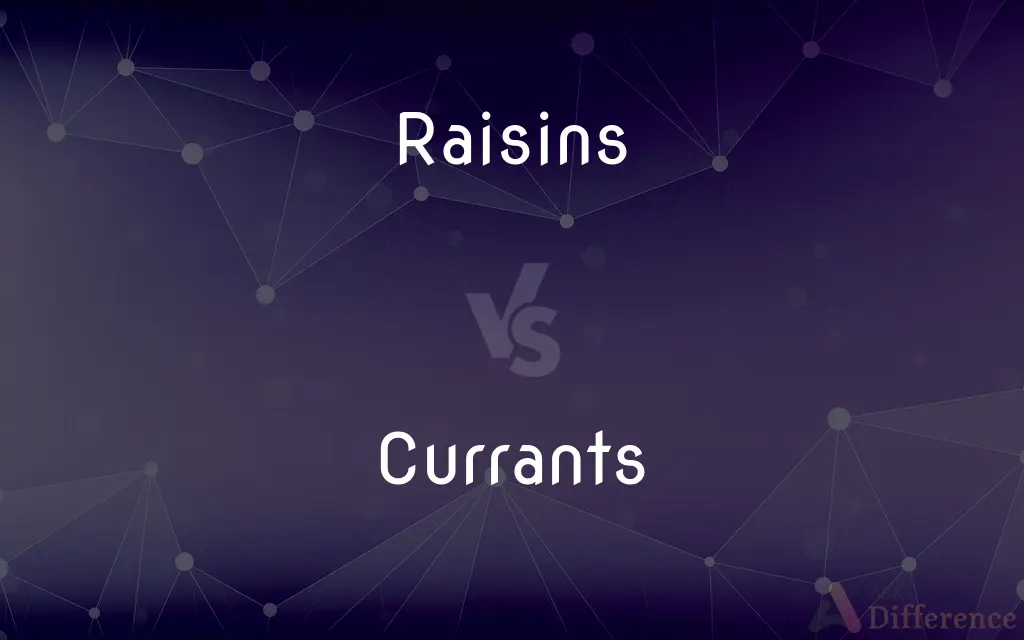Raisins vs. Currants — What's the Difference?
By Tayyaba Rehman & Urooj Arif — Published on February 4, 2024
Raisins are dried grapes, whereas currants are dried, small, dark red grapes (specific variety) or berries from the Ribes genus.

Difference Between Raisins and Currants
Table of Contents
ADVERTISEMENT
Key Differences
Raisins and currants both originate from grapes, but the grapes used for raisins are typically larger and sweeter, coming from varieties like Thompson Seedless. Currants, on the other hand, are made from smaller grape varieties such as Zante, known for their tart flavor.
Raisins come in several varieties, including golden, sultana, and black, each with distinct flavors and uses in cooking and baking. Currants, while often mistaken for the berries of the Ribes genus, are specifically dried Zante grapes and are prized for their intense flavor in baked goods.
Raisins have a global presence, produced in regions like the USA, Turkey, and Iran, adapting to different climates and grape varieties. Currants, particularly those known as Zante currants, have a more specific origin, often associated with Greek production.
Both raisins and currants are rich in sugars and fiber, but their nutritional profiles differ slightly due to the grape variety and drying process. Raisins generally contain more natural sugars, while currants may offer higher concentrations of certain vitamins and minerals.
In culinary terms, raisins are versatile, used in everything from oatmeal to savory dishes. Currants, with their smaller size and slightly tangier taste, are often preferred in fine pastries, jams, and as a garnish, offering a distinct burst of flavor.
ADVERTISEMENT
Comparison Chart
Source
Dried grapes of various varieties
Dried small Zante grapes
Size
Larger, plump
Smaller, seedless
Taste
Sweet with a chewy texture
Tart and intense flavor
Culinary Uses
Versatile in both sweet and savory
Preferred in pastries and fine baking
Nutritional Profile
High in sugars, iron, potassium
Rich in antioxidants, vitamins, minerals
Compare with Definitions
Raisins
Chewy, sweetened dried fruits often found in baked goods.
The oatmeal cookies were packed with juicy raisins.
Currants
Tiny, dried Zante grapes with a tart flavor used in baking.
I added currants to the scones for a burst of tangy flavor.
Raisins
A nutritious snack rich in energy and iron.
For a quick energy boost, I snacked on a handful of raisins.
Currants
Concentrated sources of antioxidants in dried form.
Currants in the trail mix added a tangy contrast to the nuts and seeds.
Raisins
Dried grapes used as a sweet snack or ingredient.
I sprinkled raisins over my morning cereal for added sweetness.
Currants
Small, dark, and intensely flavored dried fruits for culinary use.
Currants were the secret ingredient in the rich fruitcake.
Raisins
Sun-dried or artificially dried grapes, varying in size and color.
Golden raisins are lighter in color and slightly sweeter than their dark counterparts.
Currants
Ideal for decorative garnishes or as a flavor enhancer in recipes.
The dessert was beautifully garnished with a sprinkle of currants on top.
Raisins
A natural sweetener in cooking, from salads to desserts.
Raisins added a natural sweetness to the savory rice pilaf.
Currants
Any of various deciduous, spineless shrubs of the genus Ribes, native chiefly to the Northern Hemisphere and having flowers in racemes and edible red, black, or white berries.
Raisins
A sweet grape dried either in the sun or by artificial means.
Currants
The fruits of any of these plants, used for jams, jellies, desserts, or beverages.
Raisins
A deep brownish purple.
Currants
A small seedless raisin of the Mediterranean region, used chiefly in baking.
Raisins
Plural of raisin
Currants
Any of several other plants or their fruit.
Currants
Plural of currant
Currants
Used in gourmet cooking for their distinct, sharp taste.
The sauce for the meat dish was enriched with currants for an unexpected flavor twist.
Common Curiosities
Are currants and Ribes berries the same?
No, currants in a culinary context refer to dried Zante grapes, while Ribes currants are fresh berries.
What is the nutritional difference between raisins and currants?
Currants often have higher concentrations of certain antioxidants and vitamins, while raisins are high in natural sugars and iron.
Why are currants so small compared to raisins?
Currants come from a smaller variety of grape, specifically the Zante grape.
What are raisins made from?
Raisins are made from dried grapes of various varieties.
What are the health benefits of eating raisins?
Raisins are rich in fiber, vitamins, and minerals, promoting digestion and heart health.
How should raisins be stored to maintain freshness?
Store in a cool, dry place in an airtight container to prevent them from drying out further.
How are currants different from raisins?
Currants are dried, small Zante grapes, known for their tart taste, whereas raisins are dried from larger, sweeter grape varieties.
Can raisins and currants be used interchangeably in recipes?
While they can sometimes be substituted for each other, their taste and size differences may affect the recipe's outcome.
Can eating raisins improve digestion?
Yes, the fiber in raisins can help regulate digestion and prevent constipation.
How can I rehydrate raisins for baking?
Soak them in hot water or juice until plump, then drain before use.
What dishes are currants commonly used in?
Currants are often used in baked goods, jams, and as garnishes for desserts.
Are currants available fresh?
In the context of dried fruits, currants are not available fresh; however, fresh currants from the Ribes genus are a different type of berry.
Do raisins have seeds?
Most commercially available raisins are seedless, coming from seedless grape varieties.
Are currants good for baking?
Yes, their small size and tart flavor make them excellent for baking, especially in fine pastries.
What's the best way to incorporate raisins into a diet?
Raisins can be added to cereals, yogurts, salads, baked goods, or enjoyed as a standalone snack.
Share Your Discovery

Previous Comparison
Position vs. Designation
Next Comparison
People’s Republic Of China vs. Republic Of ChinaAuthor Spotlight
Written by
Tayyaba RehmanTayyaba Rehman is a distinguished writer, currently serving as a primary contributor to askdifference.com. As a researcher in semantics and etymology, Tayyaba's passion for the complexity of languages and their distinctions has found a perfect home on the platform. Tayyaba delves into the intricacies of language, distinguishing between commonly confused words and phrases, thereby providing clarity for readers worldwide.
Co-written by
Urooj ArifUrooj is a skilled content writer at Ask Difference, known for her exceptional ability to simplify complex topics into engaging and informative content. With a passion for research and a flair for clear, concise writing, she consistently delivers articles that resonate with our diverse audience.
















































